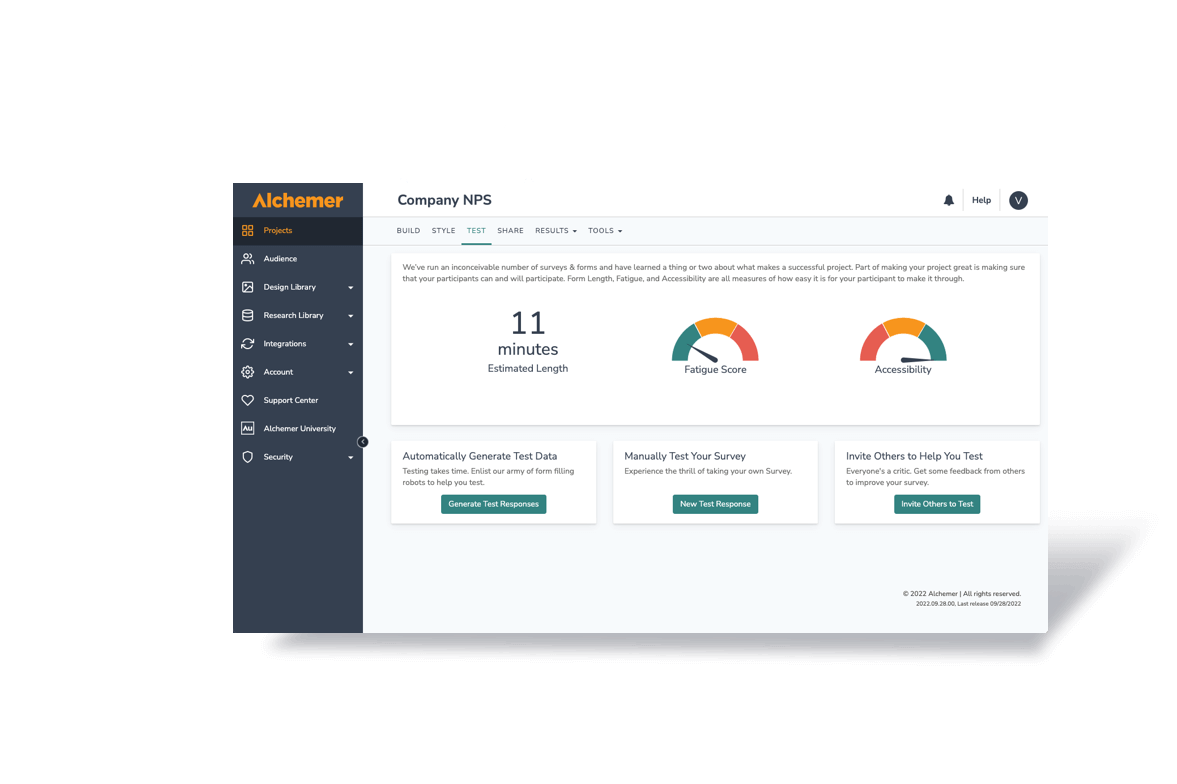You’re already sold on the importance of market research. The best way to save money and time in your company is to base your decision-making process on data. By collecting information about your specific audience and niche, you can drive true innovation. This data-driven approach allows you to make informed choices that align with your goals.
Running a successful market research project is complicated. There are many steps along the way, each with its own unique challenges. The reward, however, is greater than the sum of the challenges. We learned this from our personal experience in building software from scratch. We focused on adding and modifying features to meet our customers’ needs. This approach helped us grow our market share effectively.
This is a quick overview and guide to conducting market research with Alchemer. In this three part series, we’ll be going over just a few examples of how you can use one tool (Alchemer) to design, launch, analyze, and act on your market research.
Begin your market research by clearly defining the question you want to answer. From this point, all other methods and tactics follow.
Next, we will explore three different types of market research surveys. We’ll discuss how to approach them during the planning phase. Additionally, we’ll cover effective implementation strategies for each type. These are:
- Customer Attitudes and Expectations
- Competitive Analysis
- Conjoint Price Analysis
Finally, we address best practices for conducting research with surveys to ensure that you are reaching your audience effectively. The accuracy and helpfulness of your data depends entirely on the quality of the responses you collect. By reaching the right people, you’ll access the set of insights your company needs to succeed.
Know Where to Start Your Market Research: the Question
While it may be tempting to gather a team of your best employees together and tell them to “do market research,” this approach will get you nowhere fast. Whenever you research your customers or target audience, you’re bound to collect interesting data. Collecting truly useful data, however, is unlikely.
Entering your research phase without a plan can lead to distractions. You may find yourself overwhelmed by cluttered data and haphazard methods. This is similar to experiencing shiny object syndrome in market research.
Don’t waste time or money, and don’t get mislead by incomplete or inconsistent data. Start your market research project with a question.
That’s right. Start with just one question.
There are many ways of conducting market research and many different survey types that you can leverage to collect the data you’re looking for. Which methods and tools you use depends entirely on what question you seek to answer.
For example:
- What are your current customers attitudes and expectations about your brand and products?
- What are your competitors’ strengths and weaknesses?
- How much would people be willing to pay for your new product?
These three questions can only be answered individually, and each requires their own unique survey. In this series, we’ll take a look at each one.
Measure Customer Attitudes and Expectations with Market Research Surveys
If you don’t know what your customers really think about your industry, business, products, or services, it’s time to find out.
Measuring attitudes and expectations differs from assessing customer satisfaction, though they influence each other. Consider this: a customer might rate themselves as “satisfied.” However, if they had very low expectations from the start, that “satisfaction” only indicates you met those minimal expectations.
To achieve true excellence, you must establish high expectations for product and service quality. It’s essential to consistently meet those expectations over time.
The primary purpose of conducting attitude and expectation surveys in market research is to measure changes in customer attitudes over time. These surveys aim to identify the reasons behind those changes. Additionally, they help assess how these changes impact your bottom line, or if they have no effect at all.
Why Should You Run an Attitude and Expectations Survey?
As we’ve stated, having satisfied customers means understanding the attitudes and expectations they have towards your product or service. This is why you’re conducting market research in the first place, otherwise you’re just flying blind into the market without any clear indication of how your company can perform.
The quickest, easiest, and most direct way to ensure this understanding is through the implementation of an attitude and expectations survey.
But why, exactly, is this type of survey important?
Measuring customer attitudes towards a specific product or service allows you to understand their perceptions, tastes, and opinions as consumers. This understanding is crucial, as it highlights the primary role they play when interacting with your offerings in the market. You should avoid offering customers something that directly contradicts their tastes or preferences. Doing so could alienate them and reduce satisfaction. Additionally, you don’t want to miss out on opportunities that could attract a larger customer base with mass appeal.
Assessing Customer Expectations
Now that you have an understanding of your customers’ attitudes towards specific products and services, it’s important to also learn their expectations in these areas. As mentioned earlier, the goal is to establish high customer expectations for your offerings. By doing this, you can impress customers by consistently meeting and often exceeding those expectations. This approach fosters customer satisfaction and loyalty. Again, when expectations are low, meeting them does little to truly wow your customers into committed patronage.
Regular Surveys for Continuous Improvement
As a result, the market researcher must also survey customers on their expectations regularly. The results yield the basis for in depth reports that funnel directly into company-wide market strategy. By concentrating on areas of high customer expectations and eliminating those with low appeal, you can create a clearer picture of what products and services drive customer satisfaction. This, combined with previously assessed customer attitudes, allows you to identify the offerings that will consistently resonate with your audience. With this information, you can develop a precise market penetration strategy that effectively targets customer needs.
We must emphasize: measuring expectations and attitudes is not a one time endeavor. By checking in with your customers regularly, you will also be helping your future market research efforts. Use the data you collect now to inform your decisions around the kind of questions you ask about your competitors and the kinds of product and service improvements you make in the future.
What’s Next in This Series on Market Research?
Read the next article in this three part series where we cover how surveys can be used to collect, store, and analyze data for even your most complex competative analysis surveys (plus some tips on how to get the most from your respondents.




